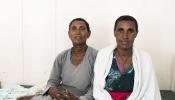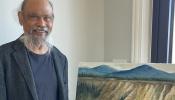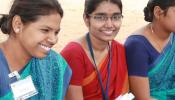From September 6-16, 2011, Dr. Marty Spencer travelled to Tibet to train local eye surgeons in cataract surgery. Dr. Spencer, an ophthalmologist in Nanaimo, is a longtime Seva board member and volunteer who has won numerous awards for his volunteer work to restore sight and prevent blindness among the world’s poorest people.
Each year Dr. Spencer travels at his own expense to different Seva programs to teach cataract surgery. This was his second visit to Tibet in two years.
Tibet has the highest rate of blindness in the world, mainly due to cataracts. A 10-minute surgery costing $50 for adults will restore sight and transform the lives of the patients and their families.
At the request of Seva Tibet, Dr. Spencer made the arduous journey to Yushu, also known as Jyekundo, a town in eastern Tibet that was devastated by an earthquake in April 2010. An eye camp was being held in Yushu and it was hoped that he could help upgrade the surgical skills of the only cataract surgeon in the city, Dr. Norbu Tzering.
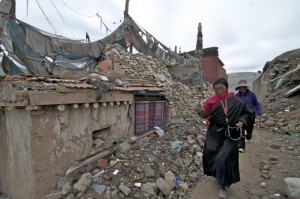
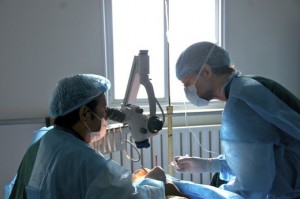
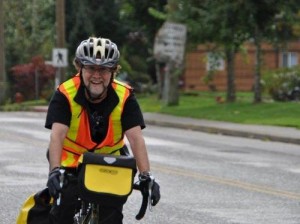
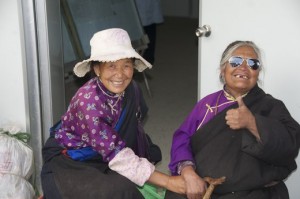

Temple in Yushu damaged by 2010 earthquake
By the end of the eye camp over 120 surgeries had been performed and the goals of teaching had been achieved. Dr. Norbu Tzering is now able to do manual sutureless cataract surgery and understands how to achieve best possible uncorrected visual acuity. In addition, a visiting Tibetan ophthalmologist from Dechen, Dr. Zhuang, achieved a more sophisticated technique and a framework with which to evaluate new technology, which he was considering for his hospital. This will be valuable for any teaching he does in future, which he appears to be very interested in.
Dr. Marty Spencer training Dr. Norbu Tzering in Tibet
Dr. Spencer not only did amazing work in Tibet but the day after he arrived back in British Columbia he took part in our Bike for Sight event and rode 62-kilometres through the Cowichan Valley to help restore sight for children in east Africa. That is some cure for jet lag!
Dr. Marty Spencer riding in Seva Bike for Sight event
We had an opportunity to ask Dr. Marty Spencer about his trip to Yushu, Tibet. Q. Why was it so important to Seva Tibet that you went to Yushu? Dr. Spencer: A Seva eye camp was being held there in September and I was asked to help upgrade the surgical skills of the only cataract surgeon in the city. The local ophthalmologist in Yushu, Dr. Norbu Tzering, had done very little routine cataract surgeries in a hospital environment. Most of the cataract surgeries in the area were done in eye-camps with visiting surgeons. This was in part because the local people wanted to have their surgery done by an outside “expert” in the belief that it would be somehow superior. My mission on this trip was to improve Dr. Norbu's skills so that surgical service could be delivered in a routine, safe and economical way. Q. What were the conditions like in Yushu? Dr. Spencer: This was not just another eye camp. Yushu was near the epicenter of a devastating earthquake 18 months ago, and to say the effects were noticeable would be an enormous understatement. The city is a sea of construction sites, fields of rubble and endless blue tents, in which most of the 100,000 inhabitants still live. When it rains, there is endless mud, and in the heat of the sun the air is so dusty you can chew it. In the midst of this makeshift living and post-traumatic suffering the sprawling, temporary pre-fab hospital provides remarkably good service. The eye camp was held in the main operating room, equipped with Seva-supplied microscopes, one there permanently, the other brought from Lhasa by Kunga Tashi, Seva’s Program Director. The staff was entirely local, with the exception of me and Dr. Zhuang, a Tibetan ophthalmologist from Dechen in the prefecture of (wait for it) Shangri-la. He is young, highly skilled, partly self-taught and interested in working with Seva in other parts of Tibet in future. Q. What were you hoping to achieve in Yushu? Dr. Spencer: My goals were to teach Norbu manual sutureless cataract surgery to improve his surgical results and complication rates. I hoped also to teach both him and Dr. Zhuang a different placement (temporal) and configuration of the cataract incision to improve astigmatism and therefore produce better visual acuity without glasses. Q. How do you train the Tibetan staff? Dr. Spencer: We started with patient assessment in the outpatient department and then a wet lab with pig eyes in the operating room the day I arrived. This might have been too much too soon from my end, as I was felled by altitude sickness that night and spent the next day in bed. The Director of the hospital was kind enough to visit me in our hotel and bring a tank of oxygen. Back in the operating room the next day, I observed the surgery of both ophthalmologists, confirming that Dr. Zhuang is highly skilled and careful. Dr. Norbu uses an older technique and had acquired some bad habits, likely from having had to often operate without a nurse assistant. I was able to make numerous suggestions. The next day I did a number of surgeries to demonstrate the temporal incision and other technical changes. In the course of the week I gave several lectures, either to the two surgeons or the entire surgical staff, as appropriate, on surgical technique, comparisons with other, high-tech techniques which they falsely believe to be superior, and recommendations to reduce risk of infection. Q. What were the results of your trip to Yushu? Dr. Spencer: By the end of the eye camp over 120 surgeries had been performed and the goals of teaching had been achieved. Dr Norbu is able to do manual sutureless cataract surgery and understands how to achieve best possible uncorrected visual acuity. Dr Zhuang achieved a sophisticated technique and a framework with which to evaluate new technology, which he was considering for his hospital. This will be valuable for any teaching he does in future, which he appears very interested in. Q. Why is it important to do eye care training in Tibet? Dr. Spencer: Before Seva started working in Tibet there was a huge backlog of people blind in both eyes with cataract, and a common cause of blindness was from badly done cataract surgery. Today 2/3 of the cataract surgery being done in Tibet is by skilled surgeons supported or trained by Seva. Patients come to hospitals and eye camps in ever larger numbers because the improved quality of the surgery results in large numbers of satisfied customers. Q. Why are you so passionate about your work for Seva? Dr. Spencer: I am privileged in having an occupation that allows me to help others. Working with Seva permits me to touch the lives of many more people than I can at home, in particular the poor who would not otherwise receive care. Shortly after I returned from my most recent trip to Tibet I heard that the two surgeons I'd trained last year had just completed an eye camp in which they operated on 267 people. I could imagine all those smiles. Q. What is the biggest challenge for you when you go overseas to train local ophthalmologists? Dr. Spencer: Adjusting to the different levels of facilities, equipment and abilities of the surgeons. And sometimes, health issues - when I flew in to Yushu, which is over 12,000 feet high, and made the mistake of immediately starting work. I was felled by altitude sickness, and spent a day in bed on oxygen before going back to the operating room. Q. If you could only say one thing to someone that you just met to convince them to support Seva, what would it be? Dr. Spencer: You're probably thankful you were born in this country rather than poor in a developing country. Imagine how you would feel being able to give sight to someone unfortunate enough to be both poor and blind in a developing country. Converting darkness and despair to light and hope is as easy as donating to Seva.
